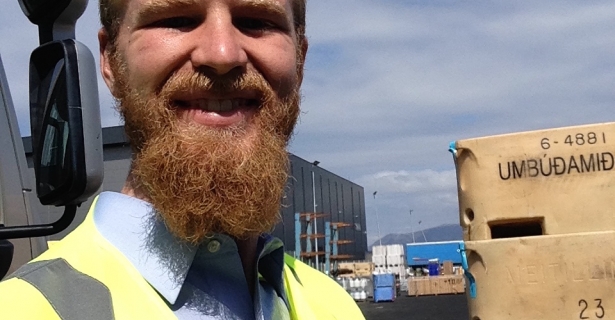Jack Whitacre is finishing credits to join the Fletcher School’s Class of 2016 and is an Empower fellow. He has been interning in Iceland this summer.
“Today you can ring the bell”, the groundskeeper beamed. Reykjavik’s old harbor could be heard outside with its clanking halyards, buzzing forklifts, and whipping winds. I took the thick rope chord and swung the old brass ship’s bell into life. It’s the last Friday coffee for the year and the chime signals to 64 tenants that it’s time to gather.
The Iceland Ocean Cluster, a group of collaborating marine companies and experts, has grown incrementally since its genesis five years ago. Inspired by the software industry, the idea behind a cluster is that tacit knowledge, innovation, and business opportunities can be maximized through an interactive network. Some cluster members are based outside of the building, but today naval engineers connect with economists and even designers over pastries, hearty oat bread, and glistening fruit.
In the last two weeks I have observed the Cluster’s organizational culture, which is independent, flat, and diverse, while studying a new social entrepreneurship movement called 100% utilization. Just like Native Americans used every part of the buffalo, there are now opportunities to use 100% of seafood in value added ways. What we may assume to be waste can sometimes be transformed into wealth. For example, chitin can be harvested from lobster shells, and amassed for high value agricultural, industrial, and medical applications. One of the most successful spin-off ventures in the Iceland Ocean Cluster has been Codland, a group that seeks to use 100% of cod.
While most North Atlantic countries use around 45% of a cod, Iceland uses 80%, driving closer every day to 100%. Instead of just using cod only for filets, Icelandic companies have created enzyme-rich creams, cosmetics, health drinks, and even fish skin leather garments, to move up the value chain from traditional fishing industry uses. The Icelandic model overcomes high volumes of discard, contributes to stronger fish stocks, and leads to more jobs and values throughout the supply chain. This approach has proven to be a solution to trends in declining fishing jobs and catch quotas. While Icelandic cod landings decreased from 460,000 tons to 180,000 tons between 1981 and 2011, the total export value of cod products actually increased from $340 million to $680 million.
At the Cluster I have collaborated with marine economists, Marine Stewardship Council certification experts, and the Iceland Sustainable Fisheries group, which is owned by Icelandic fishermen. After a tour of arguably the most high tech fish processing plant in the world, I now see the economic and environmental reasons for the United States and Europe to apply the Icelandic model.
Research trips to Reykjavik’s maritime museum provided the historical context to the utilization movement, where seafarers, including women, dropped handlines into the sea, caught fish, gutted, and then hung them to dry on driftwood racks. Personal conversations with Icelanders revealed a generational context to the current success. “We’re here only because of the blood and sweat of the generations before us,” one Icelander explained, “…many lives were lost at sea.” This mentality may be responsible for a sense of responsibility for future generations, leading to one of the best fish stock management systems in the world.
On the docks of Reykjavik the ocean is a reality not an abstraction. Coffee conversations add serendipity and inspiration to people working with determination in their chosen fields. In the Cluster people are passionate about maximizing cod utilization, growing Icelandic wasabi, designing cork aquaponic systems and micro-green partnerships with Icelandic restaurants, creating lemonade health drinks with marine collagen powered by renewable energy, re-tooling ships for whale watching, and pushing business analytics forward with big data. Two unifying themes are optimization and an interactive environment.
Upon returning to the States I hope to join a domestic cluster initiative and give life to the utilization and value added movement. The circumstances are ripe for change. In the United States 3.6 million metric tons of edible and inedible seafood was wasted between 2009 and 2013, according to the Johns Hopkins University Center For a Livable Future. Further 1.8 trillion mg of fish oil was wasted during this period, which alone represents $90 million dollars in potential value, depending on the price of fish oil and degree of refinement. With climate change, global overfishing, and declining ocean health, the Icelandic utilization and value added approaches are becoming not just relevant but requisite. As an entrepreneur in the maritime field, I hope to empower others to do more with less.


Add new comment